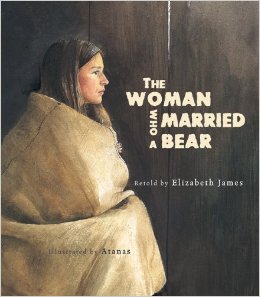The Woman who Married the bear is a wonderful story told by many Native Alaskan tribes, though each tribe tells it slightly differently. In the story, the woman insults the bear people one day and to appease them, marries the chief’s son. Over time she grows to love the bear and ends up protecting them from her human brothers and turning into a bear herself. The illustrations are beautiful in this book, and the story is told very well. The authors researched and have experience with this story as a piece of native culture, so it was presented authentically and respectfully.
I have often used books in the elementary school music room as a way for students to listen to music while putting it to story images, however, in the secondary classroom it’s a little more difficult figuring out how to bring children’s books into the performance classes like orchestra and choir. Some ideas I have:
I could use this book as an introduction to native alaskan songs, which are usually parts of stories, and to the Alutiiq people in particular who represent a mix/hybridization of many cultural traditions from Yupik to Athabaskan to Tlingit. In Alutiiq culture, the Woman who married the Bear is a major story and a song, but it has elements of the story and the songs from the Southeast native and the Yupik versions. I can see an entire lesson revolving around hybridity of Alutiiq culture and the elements of songs and stories that carry over between native tribes in Alaska.
At the end of the story, the woman sings a song in memory of her husband, the bear, who is killed by her brothers. After listening and analyzing some songs from native Alaskans, I think it would be a great exercise for students to take those words of the woman’s song and compose a melody with the same pitch set and ornamentation that is common for these songs. This would be a great opportunity to talk about how songs are generated and passed down in Alaska native cultures, the limitations of Western notation in transcribing these songs, and the purpose of songs in culture (ie: memorials, war, love songs, birth, etc.)
James, Elizabeth. The Woman Who Married the Bear. Simply Read Books: 2015.

Sophia,
I like the attention you spent to this book and how you could utilize it for your profession. It would be interesting to have children create some sort of music from a children’s book. Some books are written in poetry and have a musical rhythm that stitch the words together. If you could find a children’s book that is musical, have students take turns creating a sound to go with this book. Or you could ask students to create a song they believe to represent the book. It doesn’t have to take long. It could be an warmup exercise.
I think the fact that the story is shared among the various groups of Alaskans is fascinating. Are there other stories that were shared? Are there a lot of them? Does anyone have any idea which culture came up with this story in the first place and got it was transmitted across languages?